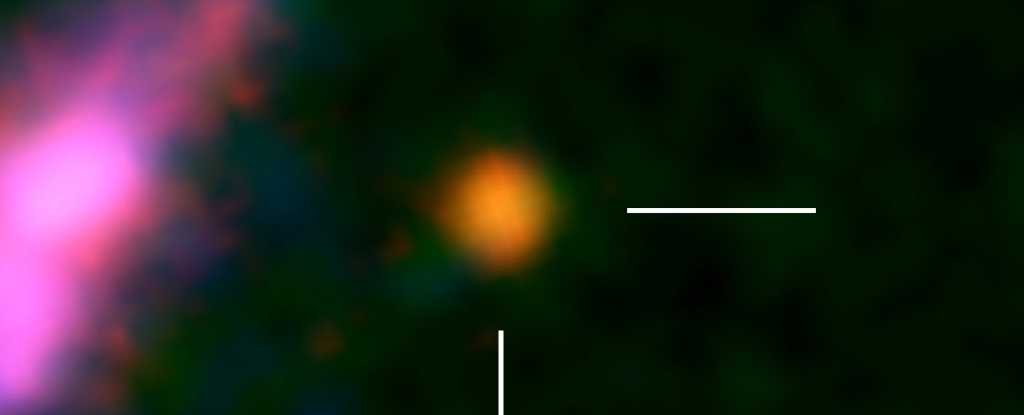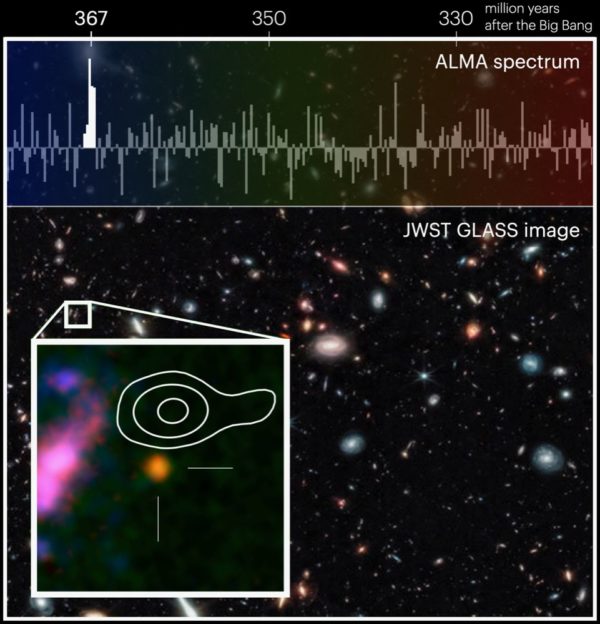
Posted on 01/30/2023 10:51:14 AM PST by Red Badger

Distant Galaxy
The image of the most distant galaxy, GHZ2/GLASS-z12. (NASA/ESA/CSA/T. Treu, UCLA/NAOJ/T. Bakx, Nagoya U)
A galaxy whose light has traveled nearly 13.5 billion years to reach us has just been confirmed as the earliest galaxy found to date.
By studying the oxygen content of the galaxy with the Atacama Large Millimeter/submillimeter Array (ALMA), astronomers have precisely dated it to just 367 million years after the Big Bang, a time when the first lights in the Universe were still switching on and starting to propagate freely through space.
The result confirms observations made by JWST, and offers new information about the early Universe that tells us about the origins of the elements.
"The first images of the James Webb Space Telescope revealed so many early galaxies that we felt we had to test its results using the best observatory on Earth," says astronomer Tom Bakx of Nagoya University in Japan.
"It was a very exciting time to be an observational astronomer, and we could track the status of the observations that will test the JWST results in real time."
The galaxy, named GHZ2/GLASS-z12, was first spotted by JWST in July of last year, not long after the telescope opened its segmented golden eye on the infrared light of the Universe.
A paper in November detailed the discovery, dating the galaxy back to approximately 350 million years after the Big Bang, which took place around 13.8 billion years ago.
That's actually pretty amazing, but any astronomical discovery is significantly more robust if it can be confirmed using an independent instrument.
So a team led by Bakx and astronomer Jorge Zavala of the National Astronomical Observatory of Japan turned to radio telescope ALMA to see what more they could learn about the fledgling galaxy.
They turned ALMA to the direction of GHZ2/GLASS-z12 and started looking for an emission signature on the radio spectrum associated with oxygen.
Since oxygen takes a relatively short time to form, it's commonly used to learn more about galaxies in the early Universe. And when light enters oxygen, it is re-emitted at a specific wavelength range, resulting in a brighter line on that part of the spectrum.

The image of GHZ2/GLASS-z12 with the associated ALMA spectrum. (NASA/ESA/CSA/T. Treu, UCLA/NAOJ/T. Bakx, Nagoya U)
Each of the 66 12-meter radio antennae that make up ALMA were put to work, ultimately detecting an oxygen emission line close to the position of GHZ2/GLASS-z12. Follow-up analyses and statistical tests determined that the signal was real, and related to the galaxy.
"We were initially concerned about the slight variation in position between the detected oxygen emission line and the galaxy seen by Webb," Bakx explains.
"But we performed detailed tests on the observations to confirm that this really is a robust detection, and it is very difficult to explain through any other interpretation."
The very slight distance between the galaxy and the oxygen emission could suggest that violent explosions or interactions stripped the galaxy of a great deal of its gas, blowing it out into intergalactic space.
The team dated their observations to a more precise 367 million years after the Big Bang. And, based on the brightness of the emission line, they were able to infer that the galaxy had relatively quickly formed high abundances of elements heavier than hydrogen and helium.
This is very interesting. The early Universe, before stars came along, was mostly made up of hydrogen with a smaller amount of helium. Then stars formed; in their hot, dense cores, they started smashing atoms together, creating heavier elements.
But these elements were locked inside the stars; it wasn't until the stars had died, exploding in spectacular supernovae, that heavier elements were able to spread through interstellar space.
This presence of oxygen so early in the Universe gives us some clues about the timing and evolution of these first stars, which we have yet to see directly.
"These deep ALMA observations provide robust evidence of the existence of galaxies within the first few hundred million years after the Big Bang, and confirms the surprising results from the Webb observations," Zavala says.
"The work of JWST has only just begun, but we are already adjusting our models of how galaxies form in the early Universe to match these observations. The combined power of Webb and the radio telescope array ALMA give us the confidence to push our cosmic horizons ever closer to the dawn of the Universe."
The research has been published in the Monthly Notices of the Royal Astronomical Society.
Who knew they have moblie homes too.
The Big Bang, et al >> Just seems like simple men trying to explain the unexplainable. It’s all supposition.
Some poster said back up the thread a possible reason for this deep-space viewing is to perhaps gather some insight and by doing so, discard the unknowable big bang theory. To be replaced by another, likely equally unknowable, theory.
Thus, pretty much just jogging in place, getting nowhere.
Question: So what was there before the universe was created?
I think we are just an alien science project.
It may have started like this:
Lisa Creates Life - The Simpsons
https://www.youtube.com/watch?v=8yA21Sso5dA
I love this question.
There was no "before" because there was no time. There was no "there" because there was no space, no time. Absolute nothingness.
Everything that comprises the universe came to be in an instant, out of nothing.
Some do not like saying how, calling it a singularity. But I'll say it. God.
The Big Bang was not an explosion.
The big bang was all matter and energy emerging from a "singularity." I and others see this as the universe emerging from absolute nothingness. No dimensions. No time. Nothing.
Outside the galaxy, the situation is as I described— all galaxies are receding from us, with more distant ones receding faster.
The galaxies in the local group which include our Milky Way and Andromeda are moving closer together. Light from Andromeda is blue shifted, meaning moving towards us. Eventually the Milky Way and Andromeda will merge. There are several former satellite galaxies that are known to have merged with the Milky Way.
Well, that radiation is still permeating the universe. It is now much less energetic because of the cooling and expansion of space, so it no longer is gamma radiation or x-rays, but rather is microwave radiation- another observation predicted and explained by the model.
As the universe cooled more though neutral atoms formed with the result that the universe became transparent. Therefore the radiation permeating the universe was free to travel everywhere within it. Well, that radiation is still permeating the universe.
You are describing the cosmic microwave background. The decoupling released photons now "free to travel" anywhere. It's those photons that form the CMB.
It's a good thing that matter after inflation and at the time of the decoupling was not evenly distributed. That can be seen in the "clumpiness" of the CMB. If it were evenly distributed, the universe a it is today would not have formed. It also had angular momentum, which allowed galaxies to form from gravitationally bound stars, planets around stars, and moons around planets.
I'm not a cosmologist or astrophysicist. I've taken an interest in cosmology in retirement, reading some undergraduate texts. Fortunately, I can understand the math!
James Webb Data Contradicts the Big Bang
https://www.realclearscience.com/2022/08/12/james_webb_data_contradicts_the_big_bang_847610.html
Isn’t what you stated a “Theory”
Very informative.
Hmm...
The Last Question by Isaac Asimov © 1956 / an excerpt
Man’s last mind fused and only AC existed — and that in hyperspace.
Matter and energy had ended and with it, space and time. Even AC existed only for the sake of the one last question that it had never answered from the time a half-drunken computer ten trillion years before had asked the question of a computer that was to AC far less than was a man to Man.
All other questions had been answered, and until this last question was answered also, AC might not release his consciousness.
All collected data had come to a final end. Nothing was left to be collected.
But all collected data had yet to be completely correlated and put together in all possible relationships.
A timeless interval was spent in doing that.
And it came to pass that AC learned how to reverse the direction of entropy.
But there was now no man to whom AC might give the answer of the last question. No matter. The answer — by demonstration — would take care of that, too.
For another timeless interval, AC thought how best to do this. Carefully, AC organized the program.
The consciousness of AC encompassed all of what had once been a Universe and brooded over what was now Chaos. Step by step, it must be done.
And AC said, “LET THERE BE LIGHT!”
And there was light——
Again educate yourself. The term theory in science does not mean what you think it does. Theories are not uncertain or conjecture. In fact a theory is pretty much the end goal of any science. If you develop a theory, you pretty much have achieved the pinnacle of your scientific discipline.
The term hypothesis better encompasses what most people think theory means. In actual fact a theory is a coherent explanatory framework encompassing multiple phenomena and backed by multiple lines of observational evidence. The Big Bang most certainly is a theory, but in this scientific sense.
Could it be wrong? Of course, but that is true of all scientific theories. If an observation is made (possibly by the James Webb telescope or by a future observation) that contradicts a prediction of the Big Bang theory then the theory will be modified or in an extreme case replaced by something else. That actually has already happened — the original BB theory did not include a period of exponential inflation and it had a singularity, a state with vanishing universal size and boundless energy. The inflationary period has been added to the model and the initial state is now a small, but finite universe with high, but finite energy, not a singularity. This has happened because we now have better observational data, such as a more refined measurement of the variations in the CMB for one example. This model is adjusted to be consistent with new data as it comes in. That is simply how science works.
“You are arguing about the number of angels that can dance on the head of a pin.” It’s one way to pass the time, I guess.
Disclaimer: Opinions posted on Free Republic are those of the individual posters and do not necessarily represent the opinion of Free Republic or its management. All materials posted herein are protected by copyright law and the exemption for fair use of copyrighted works.